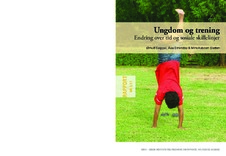Ungdom og trening
Report

Åpne
Permanent lenke
https://hdl.handle.net/20.500.12199/3363Utgivelsesdato
2011Metadata
Vis full innførselSamlinger
- NIBR notat [1018]
Sammendrag
How often and at which arenas – associations, fitness centers, un-institutionalized– do Norwegian youth exercise, and how have these exercise patterns developed over the last twenty years? How is exercise at these arenas characterized by social differences – age, gender, minority/majority, economic capital and cultural capital – in 2010? What are the youth-cultural differences between those exercising at the three arenas and those not exercising? These are the questions we answer in this report. Data applied in the report stem from three national surveys: Youth in Norway 1992, Youth in Norway 2002, Youth in Norway 2010. Each of the three studies include approximately 12000 respondents from all over Norway, covering all grades in lower secondary school and first and second grade in upper secondary school, that is mainly youth from the age of 13 to 17. Chapter 1 gives an introduction to the topics of the report, chapter 2 reviews previous research whereas chapter 3 presents data and methods. Chapter 4 addresses the development in exercise over the last 18 years, and the main finding is a pattern of stability, both with regard to members of sport associations and the frequency of exercise. The proportion reporting being affiliated to sport associations is rather stable, yet there is a decrease in the percentages saying that they never have been member of sport a association. Memberships decrease by age, and in the general picture there are no significant gender differences, but controlling for interaction between gender and minority status shows that minority girls are clearly underrepresented in sport associations. Moving from membership status to activity in sport associations, the pattern is again stability, with two exceptions. First, there are less young people saying that they never exercise in sport associations, and there are more people reporting to exercise very frequently (five times a week and more often). Exercise at fitness centers (in a rather broad meaning of the term) reveals clear shifts during the period. While 84 percents of Norwegian youths never had exercised at such centers twenty years ago, the corresponding number for 2010 is 68 percent. There is an increase in the proportion exercising at all levels of activity. Opposite to other forms of exercise, there is an increase by age when it comes to fitness. The most popular arena for exercise is what we call un-institutionalized exercise; youth exercising for themselves, alone or in smaller groups in the neighbourhood. Again stability is the main pattern, and the exceptions seem to be the same as for sport associations; fewer saying that they never exercise this way, more reporting to exercise very often. Chapter 5 looks at the extent to which exercise at the three arenas is characterized by social inequalities. While exercising at fitness centres increase by age, the pattern is opposite for all other forms of exercise. Overall gender differences are small, but when including an interaction between gender and minority status we have clear gender differences in the minority population for all forms of exercise except un-institutionalized exercise. Those with high levels of economic capital exercise more frequently in sport associations and at fitness centres, but economic capital makes no difference for non-institutionalized exercise. Cultural capital has a positive effect for exercising in associations and non-institutionalized exercise, but does not matter for fitness activities. We have also looked at the differences between those not exercising at all and those exercising at any arena. Age has a negative effect, and gender effects are small except for interaction with minority status. Both cultural and economic capital has weak but significant effects. Chapter 6 asks if activity at the various exercise arenas have consequences for the social life of young people. We distinguish between four groups: those exercising in sport association (and at other arenas), youth exercising at fitness centres (but not associations, though including non-institutionalized sport), non-institutionalized exercise (neither associations nor fitness) and those not exercising at any of the arenas. In general, we find that those not exercising are more marginal to the social field of youths, but all groups report to have steady social relations. Those not exercising spend more time in front of their PCs than others on a normal day, those exercising in sport associations the least. There are few girls, even among those not exercising, using much time at PC and PC games. Finally, we studied the relation between exercising and school and found that those exercising have better grades than those not exercising and also have more ambitious plans for their further educations. Rapporten handler om ungdoms treningsvaner i 2010 og endringer i treningsvaner fra 1992 til 2010. Deltagelse i tre typer trening omtales spesielt: idrettslag, treningssentre og det vi kaller egentrening. Videre undersøkes sosiale for-skjeller og ungdomskulturelle skillelinjer mellom ungdom som trener på ulike arenaer, og ungdom som ikke trener. Analysene er basert på tre landsrepresentative spørreskjemaundersøkelser og omfatter elever i alle trinn på ungdoms-skolen samt elever på de to første trinnene i videregående. Det overordnede inntrykket er stabilitet, både når det gjelder andelen som er medlem i idrettslag, og hvor ofte ungdom trener på ulike arenaer. Flest unge trener i idrettslag eller på egenhånd. Trening på treningssenter er imidlertid i vekst. Rapporten viser også at jenter med minoritetsbakgrunn trener mindre enn andre i idrettslag og på treningssentre, men at det er mindre kjønnsforskjeller når det gjelder egentrening. Ser man all trening under ett, er det majoritetsjentene som trener mest. Det er videre slik at en relativt større del av fritiden til unge som ikke trener, brukes foran PC-skjerme